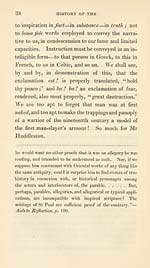Download files
Complete book:
Individual page:
Thumbnail gallery: Grid view | List view

CELTIC LANGUAGE. 39
THIRD WITNESS.
Opinion of J. a Prichard, M.D., F.R.S., M.R.S.A.,
— Vide, " The Eastern Origin of Celtic Nations."
" We have remarked above that there is historical
proof of the connexion of the Sclavonic, German, and Peles-
gian races, with the ancient Asiatic nations. Now, the lan-
guage of these races and the Celtic, although differing much
from each other, and constituting the four principal depart-
ments of dialects which prevail in Europe, are yet so far allied
in their radical elements that we may with certainty pronounce
jthem to be branc/ies of the same 07-iginal stock. The resem-
blance is remarkable in the general structure of speech, and in
those parts of the vocabulary which must be supposed to be
the most ancient, as in words descriptive of common objects
and feelings, for which expressive terms existed in the primi-
tive ages of society. We must, therefore, infer, that the
nations to whom these languages belonged, emigrated from the
same quarter.
" It will more evidently appear, if I am not mistaken, that
from the Celtic dialects, a part of the grammatical inflections,
and that a very important part, common to the Sanscrit, the
Eolic Greek, the Latin, and the Teutonic languages are
capable of an elucidation tvhich they have never yet received.'''
The Greek student will do well to read this
testimony over again, and, if he be judicious to
himself, contemplate the respectability of the au-
thority.
THIRD WITNESS.
Opinion of J. a Prichard, M.D., F.R.S., M.R.S.A.,
— Vide, " The Eastern Origin of Celtic Nations."
" We have remarked above that there is historical
proof of the connexion of the Sclavonic, German, and Peles-
gian races, with the ancient Asiatic nations. Now, the lan-
guage of these races and the Celtic, although differing much
from each other, and constituting the four principal depart-
ments of dialects which prevail in Europe, are yet so far allied
in their radical elements that we may with certainty pronounce
jthem to be branc/ies of the same 07-iginal stock. The resem-
blance is remarkable in the general structure of speech, and in
those parts of the vocabulary which must be supposed to be
the most ancient, as in words descriptive of common objects
and feelings, for which expressive terms existed in the primi-
tive ages of society. We must, therefore, infer, that the
nations to whom these languages belonged, emigrated from the
same quarter.
" It will more evidently appear, if I am not mistaken, that
from the Celtic dialects, a part of the grammatical inflections,
and that a very important part, common to the Sanscrit, the
Eolic Greek, the Latin, and the Teutonic languages are
capable of an elucidation tvhich they have never yet received.'''
The Greek student will do well to read this
testimony over again, and, if he be judicious to
himself, contemplate the respectability of the au-
thority.
Set display mode to: Large image | Transcription
Images and transcriptions on this page, including medium image downloads, may be used under the Creative Commons Attribution 4.0 International Licence unless otherwise stated. ![]()
| Early Gaelic Book Collections > Blair Collection > History of the Celtic language > (45) |
|---|
| Permanent URL | https://digital.nls.uk/76179104 |
|---|
| Description | A selection of books from a collection of more than 500 titles, mostly on religious and literary topics. Also includes some material dealing with other Celtic languages and societies. Collection created towards the end of the 19th century by Lady Evelyn Stewart Murray. |
|---|
| Description | Selected items from five 'Special and Named Printed Collections'. Includes books in Gaelic and other Celtic languages, works about the Gaels, their languages, literature, culture and history. |
|---|

